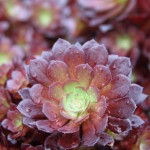Ask the Garden Guru
Garden Guru Topics
What is the best time to plant bulbs?
Dear Garden Guru,
When is the best time to plant tulip bulbs?
Pat in San Francisco
Hi Pat,
Dear Pat,
Our selection of tulip bulbs is available in the fall. It’s best to have all bulbs in the ground by Thanksgiving. Bulbs are available at most Sloat Garden Center locations.
Read more about planting bulbs here:

Aphids on succulents: help!
Dear Garden Guru,
What is the best way to get rid of aphids from my succulents? They are only damaging a couple varieties but the ones damaged are pretty bad. Thanks
Hunter in San Francisco
Hi Hunter,
You can control the aphids with Bonide All Seasons Oil. This non-toxic oil spray will smother both eggs and adults. Water your plants prior to spraying and apply when temperatures are 75 degrees or less.
Do bulbs need to be refrigerated?
Dear Garden Guru,
I have dozens of bulbs for fall planting. I've learned I have to refrigerate the crocus, hyacinth and tulip bulbs, but I'm getting mixed messages on refrigerating daffodils in Northern California. Do daffodil bulbs need to be refrigerated in this area? Anything else I should or shouldn't refrigerate? (I know about not keeping fruits in the fridge with the bulbs.) Thanks!
Susannah in Kentfield
Hi Susannah,
You do not need to refrigerate Daffodils or Narcissus. Some people keep Paperwhite Narcissus in the refrigerator to “stall” sprouting so they can force the bulbs over a longer period of time. This is probably where you are getting a mixed message. While not necessary, some people like to chill their Freesias – it seems to make the stems sturdier.
What do I grow in my container garden during the winter months?
Dear Garden Guru,
I'm from the midwest, where the winter snow prevents people from growing year round. Now that I'm in San Francisco, I have no idea what to grow in my container garden in the winter months. Any suggestions for what do on my patio from October-March would be most helpful to this midwest gardener!
Courtney in San Francisco
Hi Courtney,
You are in for a treat because the fall/early spring gardens are fun. Annuals that are available in September are stock, pansy and viola, snapdragons, paludosum daisy, and Iceland poppy. The snapdragons and poppy will look there best in early spring but are best established in the fall. The others will give you color even in the winter months. Arriving in October are primrose, ornamental cabbage and kale, and Cyclamen.
If you want to grow some edibles, lettuces, peas, broccoli, kale, Brussels’s sprouts and chard are available as starts, or you can start from seed. Best from seed are onions, carrots, beets and other root vegetables. Herbs such as parsley, thyme, sage and rosemary can be planted. Of course, our full selection of spring flowering bulbs are available in September. Bulbs over planted with violas work very nicely in pots. October is also the best time to plant sweet peas, foxglove, and California poppy. There are also fall garden mums! There’s a reason this is such a popular state.
Getting ladybugs to stick around
Dear Garden Guru,
I released ladybugs in the garden Friday evening. I saw them about on Saturday; however they were nowhere to be seen on Sunday. Do they normally leave after a day? I assume they laid eggs. How long will it be until I see more?
Susan in Mill Valley
Hi Susan,
Yes, some of the ladybugs fly off but the majority will stay. They are not so noticeable once they disperse, but they are there. The first thing they do is lay eggs where the pests are a problem. You will begin to see baby ladybugs in about 10 to 12 days. They resemble small black alligators and are the real devourers of aphids. The adult beetles eat some pests but also rely on pollens for food. You should see at least 2 generations over the spring and summer. Pupa will hang from the undersides of leaves (usually at higher levels) before hatching out as adults.
Plants for sandy soil
Dear Garden Guru,
What plants would you suggest for sandy soil in the inner sunset?
Pat in San Francisco
Hi Pat,
Sandy soil and a tad of salt wind, nothing like it!
Perennials that work are: Lantana, Euphorbia, Centranthus, Erigeron, Santolina, Phormium, Pelargonium (Martha Washington and Zonal Geranium), Limonium perezii (Sea Lavender), Armeria, Artemesia, Agapanthus, Echium, Lavender and Argyranthemum (Marguerite Daisy)
Suitable shrubs are: Rosemary, Westringia, Pittosporum tobira and Pittosporum tobira Wheelers Dwarf, Coprosma, Cistus, Hebe, Escallonia, Rhus integrifolia (Lemonade Berry), Melaleuca, Leptospermum, Correa and Dodonaea.
Trees are: Metrosideros, Arbutus, Myoporum laetum standard. Eucalyptus will also work but you don’t need the mess.
Fall Fertilizer questions
Dear Garden Guru,
What is the best fall fertilizer to use for everything from fruit trees, roses, to flowers? How often should I fertilize over the winter?
Gary in San Anselmo
Hi Gary,
Fall fertilizers are not high in nitrogen. Historically, the use of 0-10-10 or Alfalfa meal has been recommended to provide a boost to plant’s immune system to combat the ravages of coming cold weather and subsequent fungal diseases. The best practice after this is mulching or top dressing with a manure or Forest Mulch Plus (the Plus is chicken doo). Do not apply a mulch to fruit trees as this will hold excess moisture in the ground around the tree which is harmful. Don’t feed plants over the winter as this encourages new growth that can be killed by frosts. The only exception would be annual flowers such as primrose, pansies and cyclamen which are actively growing in winter.
How to amend soil?
Dear Garden Guru,
We have your basic clay earth in our backyard. I want to amend the soil. What would you recommend I amend it with? Just regular planting mix that you sell? Or should I add lime or some other soil additives like chicken manure.....what is your secret recipe? And is it better than the Colonel's?
Bruce in Glen Park
Hi Bruce,
Forest Mulch Plus, Forest Mulch Plus, Forest Mulch Plus! This is a longer lasting blend of organic materials that also contains some chicken manure (not finger likkin’ good). This mixed with Gypsum will help break down and loosen the clay. Keep in mind that one application of any product will not change the soil indefinitely. You should get in the habit of applying the Forest Mulch Plus as a top-dressing twice a year to continue to work into the soil and help keep it from reverting to it’s natural (and heavy) state.
Gardening in sandy soil -- help!
Dear Garden Guru,
Help, I am in the outer Sunset and have very sandy soil. Can you give me recommendations on soil amendment and suggestions to plant? Thank you.
Maureen in Outer Sunset
Hi Maureen,
You have the first step right re: getting the soil amended. Indeed, there are little to no nutrients in sandy soil.
Our recommendation is to mix Sloat Planting Mix into the soil, along with E.B. Stone Sure Start when planting — this will allow plant roots to acclimate to the sandy soil, and give them the best chance to spread out and take up any nutrients in the soil.
You will need to “top dress” twice a year in February/March, and again in June/July with Sloat Forest Mulch. This is a great mix that has chicken manure and bark to help hold in moisture and keep nutrients in the soil.
Plant recommendations for your soil: lavender, sage, achillea, erigeron, Ceanothus, all cacti and succulents, escallonia, Festuca and rosemary.
Also see our Mediterranean style plant list- this should offer a good selection of options.
https://www.sloatgardens.com/wp-content/uploads/2014/03/Mediterranean-Plants-handout_20121.pdf
And a link to all our soils – http://www.sloatgardens.com/pottery-soil/soils/
Container flower recommendations
Dear Garden Guru,
We just moved from the east coast. What container flowers/plants do you recommend for a west facing deck?
Karen in SF
Hi Karen,
 Welcome to the Bay Area and away from east coast winters. The only issue is what you can’t put into containers. There is a vast array of plants to choose from. My favorite go-to plants are succulents. I like to choose Aeoniums for height, echeverias, kalanchoe paddle plant and Crassula for a bushy shape and then sedums, sempervivum, senecio and ice plants to trail over.
Welcome to the Bay Area and away from east coast winters. The only issue is what you can’t put into containers. There is a vast array of plants to choose from. My favorite go-to plants are succulents. I like to choose Aeoniums for height, echeverias, kalanchoe paddle plant and Crassula for a bushy shape and then sedums, sempervivum, senecio and ice plants to trail over.
For color, I like to go with lavenders, salvia, kangaroo paws, agastache and lotus or calibrachoa to trail over. These are drought tolerant as well. Use a large pot and soil moist granules for less watering. An added bonus is that most of the plants for color attract hummingbirds. You can even mix the succulents with colorful plants; all like the same light and have similar watering requirements. Hope this helps.
Curious if we have your favorite plant or product in stock? Call one of our locations directly and we'll be happy to check.

